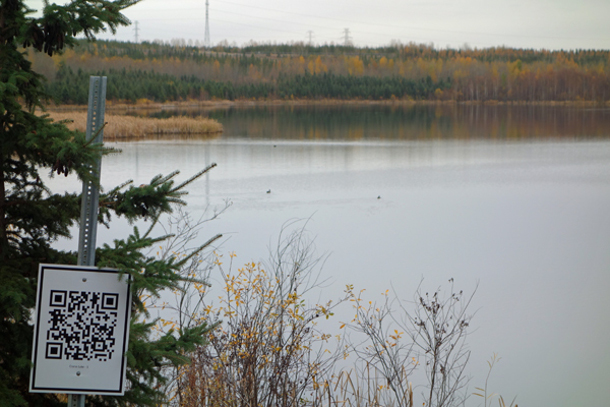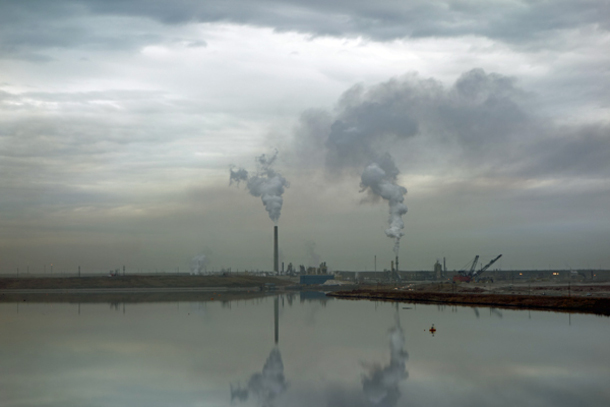The mercury hits an all-time high in Fort McMurray, Alberta earlier this month. At 22.6 degrees Celsius, it feels more like the middle than the tail end of baseball season, and the radio waves are a-gush with expressions of glee at the clemency of the holiday weekend weather.
If anyone pauses to reflect on the cause of what Environment Canada reports as "well above normal temperatures" in Alberta at the time, I don't hear it, and I certainly don't see it. Fort McMurray goes about its business, leading the country in EBIs (emissions batted in), seemingly oblivious to its outsized contribution to Canada's -- and the world's -- unfolding climate crisis.
As Supertramp asked in 1975, Crisis? What Crisis? Remember that album's cover photo of a man in a bathing suit under a beach umbrella, with factories spewing ruin into the air behind him? I think he might have emigrated from England and settled in Northern Alberta to work on his tan.
But let's be fair. You really can't read too much into a spell of record warm weather in the tarsands; you certainly can't attribute causation between the weather and the industrial activity that's happening right here in front of you (that would be unscientific); and at the very least it makes for good conditions to hike off piste, so to speak.
The official guided tours are closed for the season, so I embark instead on a self-directed tour, beginning a few kilometres north of town, where I spy a track off to the east of Highway 63 and take my rental car to the limit of its off-road abilities (or at least the outer limits of the damage waiver). I park in a clearing strewn with the brand choices that seem to be in local favour -- Budweiser, Fatburger, Tim Hortons, Trojan -- and clump through the mud for two kilometres following Poplar Creek in the hope that it meets the Athabasca River, which it does.
My hike takes place to the accompaniment of a constant grinding of truck gears and the thrum of an endless procession of vehicles of all sizes, mostly ranging from large to huge, headed north to the mines. As I approach the river, the noise behind me lessens, only to be replaced by vehicle noises from operations on the other side of the stream, where a tailings pond's massive wall comes recklessly close to one of Canada's major sources of fresh water.
It being hot and all, the trek is thirsty work. I haven't packed any water, but I am (unscientifically) disinclined to drink from the river. It's a magnificent body of water, Alberta's longest river, and it is thrilling to see it up close. But it's hard to shake off a feeling of foreboding that the province's only undammed river might also be its most damned.
More good news
Back in the rental car, more good news for McMurrayans. CBC Radio reports that the Alberta Energy Regulator has just approved the $3-billion Grand Rapids pipeline, designed to ship up to 900,000 barrels of diluted bitumen per day from the tarsands to the Edmonton area. What with all the opposition to Northern Gateway, Keystone XL and Energy East, it's a relief to hear that the local regulator is on-side.
A regulator is defined, by Merriam-Webster at least, either as a "device for controlling the level or amount of something," or as "the part of the government that controls a public activity by making and enforcing rules." You might even think of a flow regulator, which can limit what passes through a tap, say, or a pipeline. In Alberta, the newly named energy regulator (previously the Energy Resources Conservation Board) operates more like a broken fire hydrant. That said, it has attached 26 conditions to its approval -- stuff like "enhanced environmental monitoring and mitigation to better protect wildlife and wetlands." Well, that's a relief, too. Should be enough to shut up those urban environmentalists and noisy natives.
Maybe Alberta's stellar reputation for monitoring and mitigation is part of the reason why -- something else to be thankful for, in this Thanksgiving month! -- the Canadian government has succeed in convincing the European Union not to follow through on plans to label tarsands oil as dirty. That clears the way for exports of tarsands crude to European markets, assuming TransCanada Corp's $12-billion Energy East pipeline gets the, er, regulatory go-ahead.
Driving north, more good news. Syncrude's reclamation work is proceeding apace, including a few acres of Gateway Hill "reclaimed in 1983" and "returned to nature." Across the highway, a roadside sign alerts me to the "watchable wildlife" at Suncor's Crane Lake Reclamation Area, where another a helpful sign describes how wetlands are made: 1. Landscape a storage pond for excess tailings. 2. Conduct other mining activities that cause the pond to fill with fresh water (oops, didn't see that coming!). 3. Presto, a "new wetlands ecosystem [is] born... a rich habitat for wildlife and a popular recreational area for the people of the Wood Buffalo region."
I count three ducks and no people. But speaking of buffalo, or at least bison, back over at Syncrude there are 200 to 300 of "some of the healthiest bison in Western Canada" grazing on its reclaimed land, apparently unfazed by the constant cannon sounds designed to stop birds landing on the toxic waters that surround them. Given that the World Wildlife Fund has just released a report saying that, since 1970, about 52 per cent of the world's biodiversity has been lost, it's a relief to know that "habitat" can so readily be brought back on stream.

It's trespassin' time
I plough north, into the mining and emissions zone shared by Suncor and Syncrude's long-lived operations and, too bad for them, the First Nations and Métis communities at Fort MacKay. Other developments are popping up all over the place, all with the approval of the energy regulator. I climb a gate to get a shot of the new Fort Hills development and get yelled at by a security guard. Later I kinda trespass, truth be known, on what used to be a boreal forest and is now a huge clearcut making way for yet another development, or maybe another Soviet-style encampment for the fly-in, fly-out workers who keep the whole enterprise humming around the clock.
A slight downer arrives in the form of an audit by Julie Gelfand, Canada's commissioner of the environment and sustainable development, who notes that draft emissions regulations for the oil and gas sector, promised in 2006, still haven't been released. Gelfand also notes that the federal government has no firm plans to monitor the oil sands beyond next year, but I'm confused as to whether that's good news or bad news.
Meanwhile, Canada remains on pace to fall short of its Copenhagen-agreed goal of reducing greenhouse gas emissions to 17 per cent below 2005 levels by 2020. Our target is to release just 612 megatons then, yet we're on pace to emit 734 megatons. Maybe industry forecasts of a 70 per cent rise in production from the tarsands by 2020 has something to do with that? Well, at least a lot of jobs are safe.
Meanwhile, Gelfand's review of the Joint Oil Sands Monitoring program set up in 2012 notes that Ottawa has failed to include Aboriginal traditional knowledge in its work. This possibly should come as no surprise, since just a few weeks ago, Canada yet again distinguished itself by being the only country -- as in the only country in the world -- to raise objections over a landmark document that UN Secretary General Ban Ki-moon says "set[s] minimum standards for the survival, dignity and well-being of Indigenous peoples."
What has offended our federal government, apparently, is "elements contained in this outcome document related to free, prior and informed consent." That's something that could be interpreted as "a veto to Aboriginal groups and in that regard, cannot be reconciled with Canadian law, as it exists," says the government.
Thanks must be given, one supposes, for that fact that just like the provincial government, Ottawa's got the tarsands' back. No pesky science, no real limits on production and emissions, "conditions" but no real hesitation in approving pipelines in every which direction, and no real risk that those uppity natives will stand in the way. Unless they do.
After a week of poking around the tarsands, I cannot help feel something akin to awe at the sheer audacity of what's being done here. More on that, as and when. Leaving Canada's can-do province to return to Vancouver, where the whining continues about Enbridge and Kinder Morgan and LNG and fracking, at least there's some good news to be had. Here in B.C., we too have our regulators, and they too collude with Ottawa, and hey, we might not have tarsands like they do alongside the Athabasca River, but we've got the Peace River at our mercy and we can flood that, eh? And thanks be to Christy and Bill's brilliant vision, we'll have cheap energy far into the future.
Site C? Bring it on. Drown baby drown. ![]()
Read more: Energy, Environment
















Tyee Commenting Guidelines
Comments that violate guidelines risk being deleted, and violations may result in a temporary or permanent user ban. Maintain the spirit of good conversation to stay in the discussion.
*Please note The Tyee is not a forum for spreading misinformation about COVID-19, denying its existence or minimizing its risk to public health.
Do:
Do not: